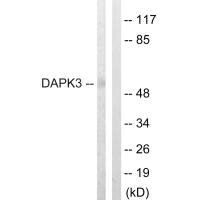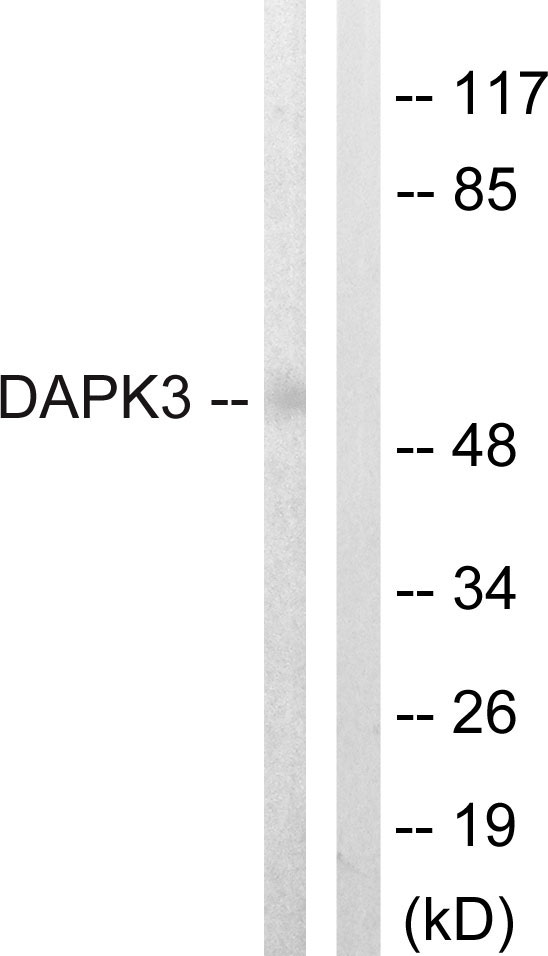
Western blot analysis of extracts from HuvEc cells, using DAPK3 (Ab-265) antibody.
DAPK3 (Ab-265) Antibody
CSB-PA994602
ApplicationsWestern Blot, ELISA, ImmunoHistoChemistry
Product group Antibodies
TargetDAPK3
Overview
- SupplierCusabio
- Product NameDAPK3 (Ab-265) Antibody
- Delivery Days Customer20
- ApplicationsWestern Blot, ELISA, ImmunoHistoChemistry
- CertificationResearch Use Only
- ClonalityPolyclonal
- ConjugateUnconjugated
- Gene ID1613
- Target nameDAPK3
- Target descriptiondeath associated protein kinase 3
- Target synonymsDAP kinase 3; DAP-like kinase; death-associated protein kinase 3; DLK; MYPT1 kinase; ZIP; ZIPK; ZIP-kinase; zipper-interacting protein kinase
- HostRabbit
- IsotypeIgG
- Protein IDO43293
- Protein NameDeath-associated protein kinase 3
- Scientific DescriptionSerine/threonine kinase which is involved in the regulation of apoptosis, autophagy, transcription, translation, actin cytoskeleton reorganization, cell motility, smooth muscle contraction, and mitosis, particularly cytokinesis. Regulates both type I apoptotic and type II autophagic cell deaths signal, depending on the cellular setting. The former is caspase-dependent, while the latter is caspase-independent and is characterized by the accumulation of autophagic vesicles. Regulates myosin phosphorylation in both smooth muscle and non-muscle cells. In smooth muscle, regulates myosin either directly by phosphorylating MYL12B and MYL9 or through inhibition of smooth muscle myosin phosphatase (SMPP1M) via phosphorylation of PPP1R12A, and the inhibition of SMPP1M functions to enhance muscle responsiveness to Ca2+ and promote a contractile state. Enhances transcription from AR-responsive promoters in a hormone- and kinase-dependent manner. Phosphorylates STAT3 and enhances its transcriptional activity. Positively regulates the canonical Wnt/beta-catenin signaling through interaction with NLK and TCF7L2. Can disrupt the NLK-TCF7L2 complex thereby influencing the phosphorylation of TCF7L2 by NLK. Phosphorylates histone H3 on Thr-11 at centromeres during mitosis. Involved in the formation of promyelocytic leukemia protein nuclear body (PML-NB), one of many subnuclear domains in the eukaryotic cell nucleus, and which is involved in oncogenesis and viral infection. Phosphorylates RPL13A on Ser-77 upon interferon-gamma activation which is causing RPL13A release from the ribosome, its association with the GAIT complex and its subsequent involvement in transcript-selective translation inhibition. Isoform 2 can phosphorylate myosin, PPP1R12A and MYL12B. Kawai T., Mol. Cell. Biol. 18:1642-1651(1998). Murata-Hori M., FEBS Lett. 451:81-84(1999). The MGC Project Team; Genome Res. 14:2121-2127(2004).
- Storage Instruction-20°C or -80°C
- UNSPSC12352203







